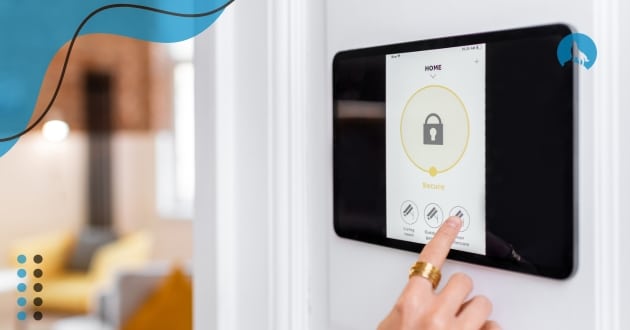Smart home automation systems are revolutionizing the way we interact with our living spaces. Over the past decade, advancements in technology have paved the way for innovations that offer convenience, security, and energy efficiency at the touch of a button or the sound of a voice command.
From controlling your home’s lighting to adjusting the thermostat, these systems are designed to make life simpler, more connected, and more efficient.
As technology continues to advance, the adoption of smart home automation systems is becoming more widespread, with millions of households around the world integrating these systems into their daily lives.
Gone are the days of manually turning off lights or worrying about leaving the heating on. With smart home systems, you can automate everyday tasks, save energy, and even improve your home’s security, all from your smartphone, tablet, or voice-controlled assistant.
Moreover, smart home automation systems are not just about convenience; they also offer significant benefits in terms of energy management, safety, and overall quality of life.
What Are Smart Home Automation Systems?
Smart home automation systems are designed to integrate technology into everyday living spaces, allowing homeowners to remotely control various devices such as lights, thermostats, and security systems through smartphones, voice assistants, or automated schedules.
These systems enhance convenience by automating routine tasks, improving the comfort of living spaces, and offering real-time control from anywhere in the world.
As part of the broader Internet of Things (IoT), smart home systems provide a seamless way to optimize energy usage, boost security, and make everyday tasks more efficient.
One of the key benefits of smart home automation systems is their ability to improve energy efficiency. Smart thermostats, for example, can learn your preferences and adjust heating or cooling automatically based on your schedule, reducing energy waste and lowering utility bills.
Similarly, smart lighting systems can be set to turn off when not in use, helping to conserve power. These features not only save money but also contribute to a more sustainable environment.
The rise of smart home automation systems has also led to a significant demand for professionals in the technology field. As more homes adopt these systems, the need for skilled workers, such as engineers, developers, and installers, continues to grow.
This shift has created numerous career opportunities in the tech industry, making smart home technology an important driver in the field of technology careers in demand. The integration of these systems is not only transforming homes but also shaping the job market for years to come.
The Components of Smart Home Automation
A smart home automation system consists of various components that work together to create a seamless experience. Some of the most common components include:
- Smart Thermostats: Smart thermostats are one of the most popular smart devices for the home. Popular models like the Nest Thermostat even allow you to control the temperature remotely through an app.
- Smart Lighting: Smart lighting systems let you control the brightness and color of your lights using voice commands or smartphone apps. You can set schedules to turn lights on or off at specific times, or even automate them to respond to certain events, such as when you arrive home or when a motion sensor detects movement.
- Smart Security Systems: Security is a primary concern for many homeowners, and smart security systems offer peace of mind. These systems can include smart cameras, doorbell cameras, motion sensors, and smart locks. You can monitor your home in real-time via your phone and receive alerts if any suspicious activity is detected.
- Smart Appliances: From refrigerators to ovens, smart appliances are revolutionizing kitchens and homes. Smart refrigerators can track expiration dates, suggest recipes, and even alert you when you’re running low on groceries. Smart ovens can be preheated remotely and allow for voice-controlled cooking.
- Voice Assistants: Many smart home automation systems are integrated with voice assistants like Amazon Alexa, Google Assistant, or Apple Siri. These assistants allow you to control various devices using voice commands, making it even more convenient to interact with your smart home.
How Do Smart Home Automation Systems Work?
The backbone of smart home automation systems is the Internet of Things (IoT). IoT devices are interconnected through the internet, allowing them to communicate with one another and be controlled remotely. Here’s a basic breakdown of how they work:
- Devices and Sensors: Each smart device, whether it’s a thermostat, security camera, or smart lock, has a sensor that detects changes in the environment or user input. For example, a smart thermostat may sense a temperature change, or a motion sensor in a security camera may detect movement.
- Communication via Wi-Fi or Bluetooth: Once a sensor detects a change, it sends a signal to a central hub or directly to a smartphone app. This communication is usually done over Wi-Fi or Bluetooth. For more advanced setups, some systems use Zigbee or Z-Wave, which are wireless communication protocols designed specifically for smart home devices.
- Central Hub or App Control: The smart home system is typically controlled through a central hub or app. The central hub connects to your devices and allows them to communicate with each other. Many systems also allow you to control devices using a smartphone app, giving you remote access to your home.
- Automation and Scheduling: One of the most significant advantages of smart home automation systems is the ability to automate certain tasks. For example, you can schedule your lights to turn off when you leave the house, or your thermostat to lower the temperature at night. This automation helps save energy and ensures your home is always running efficiently.

Benefits of Smart Home Automation Systems
Smart home automation systems offer a wide range of benefits that can improve your daily life in many ways. Here are some of the key advantages:
- Increased Convenience: The most obvious benefit of smart home automation systems is convenience. With the ability to control your devices remotely through an app or voice assistant, you can manage your home from anywhere. Whether you’re at work, on vacation, or lying on the couch, you can adjust your home’s lighting, temperature, and security systems with just a few taps on your phone or voice commands.
- Energy Efficiency: Smart home automation can significantly reduce energy consumption. By using systems like smart thermostats, which adjust the temperature based on your schedule, and smart lighting, which can be turned off automatically when not in use. Additionally, some systems provide detailed energy usage reports, so you can track where your home is consuming the most energy and make adjustments accordingly.
- Enhanced Security: With smart home automation systems, you can enhance your home’s security. Smart cameras and doorbell cameras allow you to monitor who is at your door, while motion sensors can detect unusual activity around your property. Smart locks provide the ability to lock and unlock doors remotely, and you can even set up alerts to notify you if a door or window is opened unexpectedly.
How to Choose the Right Smart Home Automation
Choosing the right smart home automation system can be overwhelming, given the many options available on the market.
- Compatibility: One of the most important factors to consider is compatibility. For example, if you have an Amazon Echo, ensure the devices you choose are compatible with Alexa. Also, check whether the system supports both Android and iOS devices if you need flexibility in controlling your home.
- Customization: Different smart home systems offer different levels of customization. Some systems allow for detailed scheduling and automation, while others may be more basic. Consider your needs and how much control you want over your system before making a choice.
- Security Features: Security is a top priority for many homeowners. Be sure to choose a system that offers robust security features, such as encrypted communication, two-factor authentication, and real-time alerts.
Conclusion
In conclusion, smart home automation systems are no longer a futuristic concept but a tangible reality that is enhancing the way we live. These systems offer unparalleled convenience, energy efficiency, and security, making them an essential part of modern homes.
The ability to control lighting, temperature, appliances, and security from anywhere in the world through a smartphone or voice assistant adds a level of ease and control that was once unimaginable.
As technology continues to evolve, these systems will only become smarter, more integrated, and more beneficial to homeowners worldwide. Beyond the personal advantages, the rise of smart home automation systems has created a significant shift in the technology job market.
The growing adoption of smart devices has driven demand for skilled professionals in areas like system installation, maintenance, and development. As more homes transition to smart living, the need for experts in this field will continue to increase, offering exciting career opportunities for those looking to enter the technology sector.
This trend highlights the broader impact of smart home technologies, not only in improving lives but also in shaping the future of technology careers in demand.
For more detailed insights into smart home automation systems, trends, and career opportunities, you can visit SmartThings Samsung, a reputable source for the latest developments in the field.
By embracing these technologies today, homeowners and professionals alike are positioning themselves at the forefront of a transformative shift in how we interact with our living spaces, making smart home systems an integral part of the future.


